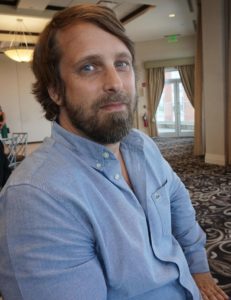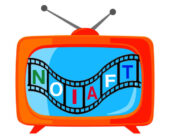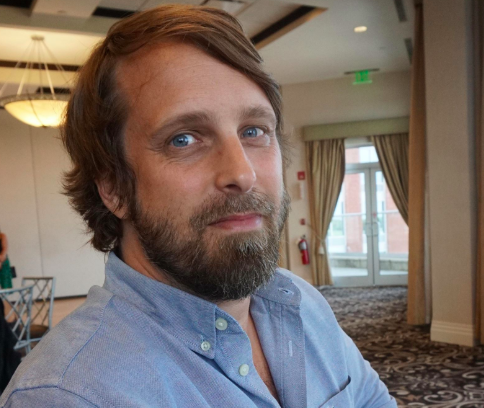
NOIAFT founder, Taylor Taglianetti, had the opportunity to participate in a roundtable interview with Crawl director, Alexandre Aja and a number of other journalists. Here’s what they discussed:
Q: Keeping in mind for the box office, was there anything you brought to the film that lent an international flair? That is, being in Serbia, having British actors, Canadian actors…?
Aja: No, you know what…it’s something that I had a discussion about very early on in the process where people think: “Yeah, but why would people get scared if they don’t live in Florida?” I never felt that because I’m French and I read the script and I thought about the story and I was really scared all the time when developing that project. I think it’s the simplicity of the monster that’s international. What lies beneath the water…what lies beneath in that storm and that disaster that is more and more coming to us. It’s something that we can all relate to. I mean, the flooding, for sure. Flooding is pretty much international right now. And then, we all have some kind of weird neighbors that are very old and nasty.
Q: You also had technical challenges that you never faced before. There’s no school for this.
Aja: You know, I thought that I knew better because I made Piranha a few years ago and shooting in the water was very, very tough and I did check the rule book of everything that goes wrong from Jaws and Waterworld and all that stuff before and I was not expecting that to happen again. Crawl was the most difficult one that I ever faced. We had to build seven tanks. The biggest one was ten times, I mean, this room for the gas station, all the house. Everything was on blue screen, with 100 mile per hour winds and rain all the time. It was not only being on the water, it was also being off in the water with wind and rain all the time. That was pretty nasty.
Q: Was there something that you were anticipating being really difficult that was actually really easier?
Aja: The dog. The dog was, you know, like you had to do very specific things. It was sometimes annoying. You had to keep the fan on all the time because the dog, if you stop the fan the change of sound will, you know, change the mindset of the dog. But beside that, she was spectacular. She was like, you know, like trained and I was convinced that it would be the biggest problem on the set and it was very easy in the end.
Q: Was there something that turned out to be harder than you expected? Was there something that when you see it in the final cut you say “ Oh – this wasn’t supposed to—“
Aja: You know what, we spent weeks of prep thinking about how we are going to build all those sets and thinking how we are going to create this location and at the end, everyone comes with an expertise of this is how you do, this how you, you know, like I could, I think, I spent weeks thinking about just the different type of tank you can create. At the end of the day, no matter what, the tank broke, the water spilled, the set got flooded and you cannot bring back. Like all those things, like the unexpected, you know, can happen when you deal with water
Q: You’ve had this evolution and oddly enough, I’ve thought more and more about the film, and it’s really a little bit of a departure. You always have a little bit of a departure in there and all of your films have strong women. Do you see a through line in your career and then do you see a departure here? Do you coalesce something where you’re telling a relationship as well as a horror, a fantasy…?
Aja: It’s definitely the mix of genre is something I kind of like as a moviegoer. I know it’s a difficult one and sometimes it’s disturbing and we had some issues with homes and I love the way we mix genre but I don’t do it really on purpose, but it’s true that maybe this one is very similar to intention in many ways. I went back to something that was more straightforward and suspenseful. I wanted to craft an experience for the audience, something very immersive. Something where you actually have to see in a movie theater, to live it in a movie theater, to be inside the movie. And talking about characters, I kind of always project myself into the character as the same way for intention. Here, for me, the character saving a dad was the interesting part. The idea of that young woman who has to go save a dad was very new. Something that was also interesting to me is that idea of a new generation trying to save that more old school, very Floridian type of dad. Some things I find very timely about the times we’re living in right now. You know, natural disasters becoming more and more prominent on a global scale. And at the same time that generation indirectly participate to create that situation having to be saved by the new generation.
Q: How much fun did you have manipulating the tension, even in the quieter scenes? I think they have the big conversation like The Reckoning but I was convinced you were going do like a Deep Blue Sea moment.
Aja: We did do the Deep Blue Sea moment! We did with the cop. It’s a classic. The Deep Blue Sea moment is a classic. It always works. The cooking of this kind of suspenseful ride is you go with your instinct. There are no rules. You know, like, I think of myself as an audience member before being a filmmaker so I’m always thinking about what I would like to see and give some breathing room and some laughing to ease the tension, then you go stronger. One thing that I thought a lot on this movie that I really wanted to happen was the fact that I’m tired about this “less is more”. Studios, producers, everyone is always like less is more. Don’t show the alligators, don’t show them…keep them in the dark. And I was like no…everyone knows what is an alligator. We want to see them. We want to actually do the opposite. We want them to jump straight at your face. See them so everything is possible then and that’s something I’m very happy the movie got at the end.
Q: Will alligator fans be mad at you? In terms of what alligators can do and cannot do?
Aja: No, no. It’s a best of. It’s a best of all the nasty things that they can do. It’s very unlikely that alligators in the time of the day will do all those things, but they did each of them at some point, somewhere. We look into a lot of references and everything is based on the realm of possibilities. I didn’t want to do a monster movie with a giant radioactive alligator. I wanted to do something because they are just perfect the way they are. They are crazy killing machines and I like the idea of inviting them into the domestic setting. I think that’s more and more formidable with the ticking clock of the water rising.
Q: So you’re also producer on the film. Does the producer side of you ever conflict with the directing side?
Aja: That’s what my other producers are saying, but I don’t feel it. They’re saying yeah you stop being a producer the day you start directing. I don’t think so. I think that I’m still fighting until the end to get the best movie possible, at least the movie I really want to see and the most intense one. It’s always challenging.
Q: I know you’ll work with a dog again, but will you work with alligators? Is there a sequel possibility?
Aja: Yeah, always. A lot of things happen during that storm and in other places so you can imagine a lot of different stories and there are a lot of other settings that are interesting with the water. When you combine two types of elements and the disaster and the creature, it’s a very good setup to create set pieces.
Q: But no piranhas meet alligator?
Aja: No, but we were thinking about it. If you want to be very realistic about Florida, there’s as much snake as there are alligators so we should have done alligators and snakes together
Q: So it’s our responsibility to make sure you have a successful film to make sure we see the sequel…Anyway, given that you’ve come up with all these twists and turns…you’ve done your genre remake and so on. What is in your wheelhouse…what do you want to do next that will add to that catalogue?
Aja: I’m still looking into doing a really scary haunted house movie. This is something that I didn’t do. I produced one of them, but I didn’t do it yet. That’s something that I would love to explore. There are other creatures, you know, spiders will be very interesting to explore.
Q: You had your spider scene in there!
Aja: Just a little touch! Spiders will be very interesting to explore.
Q: What creeps you out the most?
Aja: A lot of things. I’m a really good client. I get scared very easily. I’m stupid. I have a strong fear for supernatural things even if I don’t believe in them. It’s just like that kind of contradiction of human nature of not believing and at the same time being scared of things. Yeah, I think the supernatural is more scary for me than the real but at the same time, like a good alligator coming inside the house is always scary.
Q: Would you do a superhero film?
Aja: Yes. You know there are a lot of superheroes that I love. I grew up reading all the Marvel superheroes and I love a lot of these movies. Some of my favorite have been put on the screen already for a long time. I tried for a long time to be a good candidate for Wolverine, but you know.
Q: You have a lot of good French comics that you could be doing. You must have read Métal hurlant?
Aja: Of course, of course. There are a few that we have tried to develop. On the superhero side, we are not that good. We are great on sci-fi, definitely.
Q: You can do Fantômos.
Aja: Yes, we talked about it for a long time. It’s too, um, I don’t know how you’d do it. You have to do it in the way it was done in the early origin of Fantômo when he was the joker before the joker at the early turn of the century, as an anarchist. That was pretty interesting.
Q: How do you see the future of the movie theater going experience, especially for the creature feature and horror genre?
Aja: I mean, it is like sad and a little scary and to see how little movies find their ways to the big screen and I’m blessed. I mean, we are making our movies…we are very, very lucky because so far, our movies, our movies are the only movies that maintain a reason to go see it in a big theater and are successful like A Quiet Place, Don’t Breathe, It, all those giant success are first theater experience. It’s not easy to challenge this superhero or Star Wars or all that stuff. I still feel like for the genre, it’s still like the best time because we have room in the theater. I hope that we will still maintain that room. I hope that there will be enough successful movies out the next few years to resist and still be in theaters.
Q: You mentioned making with the theater in mind. Would this have been the same movie if you knew you were going to a streamer first?
Aja: You know what, I don’t think so…on the few small level of framing. When you frame for the theater, you have more room to frame wider. I think I will try to do this for a theater, but you would know that audience would not experience it the same way. You know like watching Roma in a big theater is nothing compared to watching it on your TV because of everything you’re discovering.
Q: You mean the other way around.
A: Yes, yes. Basically the difference of watching it on a big screen is that it’s phenomenal compared to seeing on TV, which is a great movie, but still seeing it on TV.
Q: Do you have one character you’d like to do, even if done by other people already?
Aja: I have one character that goes back to my childhood nostalgia. It’s a manga character that I tried to put into a movie called Cobra The Space Pirate. We tried to do it for a few years. It‘s a great kind of adventure, space opera kind of thing. But, maybe one day.


6JMGAU46 http://www.yandex.ru